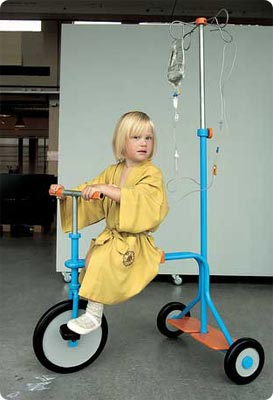Health Care … a timely topic. This post features some of the health related projects I’ve come across in my research on design activism. Designers surely can’t affect the health insurance situation–or can they, service designers?–but the projects below show some of the other categories where designers are trying to improve health outcomes and experiences of health care.

Massachusetts General Hospital’s rooftop healing garden
Things
Designers have been working on a range of things, or products, to improve health “performance.” One example is a range of new pill bottles that are easier to read, that talk, or that will call and remind you when to take their pills (Metropolis article here). Similar interventions are occurring in child-friendly medical devices, such as the IV tricycle that lets children drive their IV around with them. The tricycle was a project of student Jetske Verdonk at the Design Academy Eindohoven.

Tricycle IV by Jetske Verdonk at the Design Academy Eindohoven
Interior architecture
A number of practitioners are taking aim at the interior construction and finishes in hospitals and health clinics. Not only are designers realizing that ecological design is good for human health, but they’re also starting to look at health more holistically.
One example is an Italian clinic that started with the human being at the center, rather than starting with a web of regulations for hygiene, efficiency and technology. Designer Giannantonio Vannetti took a holistic approach that encompassed daylight, color, art, and gardens. (Metropolis report here.) For example blue has a calming quality and yellow has a quality that soothes pain. A mounting body of research shows that patients recover more quickly when exposed (even if only through a view) to nature.
Research in the UK has also highlighted the general mediocrity in hospital design. The Commission for Architecture and the Built Environment and the Royal College of Nursing published a report on radical improvements in hospital design addressing similar holistic issues.
Landscape
I noted above that nature, either being in it or seeing it, helps patients recover better, and some hospitals are starting to pick up on this finding. Two particular manifestations occur in labyrinths and healing gardens. The first labyrinth was installed in a California hospital in 1997. The labyrinth project has documented many more since then. The group also has an article on labyrinths in hospital/healing settings.

Labyrinth by Labyrinth Enterprises installed at West Clinic in Memphis TN
Massachusetts General Hospital offers an example of a rooftop healing garden which provides therapeutic benefits as well as energy savings. The garden was designed by Cambridge Seven Associates and Halvorson Design Partnership, who focused on the user experience. The soil layer of the garden acts as effective insulation.
Reform versus transformation
The above examples are all in the vein (pardon the pun) of health care reform. That is they each suggest reforming the equipment, the interiors and the landscapes of our health care environment.
But there are also designers thinking about transformation of the way we address health. One example of a transformative approach comes from a public health doctor. Dr. Richard Jackson argues that our car-dependent suburban life is so unhealthy that it may be killing us. His book, Urban Sprawl and Public Health (with Frumkin and Frank) details these arguments. For example, instead of using drugs to treat depression, high blood pressure, or obesity, doctors should be politically and socially fighting for communities that do not rely on us sitting in cars for hours each day. Similar arguments and research stem from groups such as Active Living by Design, a program of the Robert Wood Johnson Foundation.
Adding to the transformative way we look at health, recent work at University College London makes explicit the links between health and climate change. The UCL team focused on key areas: patterns of disease and mortality, food security, water and sanitation, shelter and human settlements, extreme events, and population migration.
A final example of transformative ways of thinking about health care emerges from work of the Design Council in the UK. Their research looked at the notion of “co-creating” health through expert patient forums and other systems approaches, often supported by networked communities. I keep a copy of this report on my website here. Further work stemming from Design Council program Design of the Times (DOTT) also addressed design interventions in health care (sexually transmitted diseases, dementia and “cyborg” implications for health).
— — —
Are these the best ways for designers to engage in health care? How could they play a bigger and more effective role in the debate, given that the role of design is necessary, but not sufficient, to solve the problems…
P.S. Change.org’s blog on social entrepreneurship also published a post on health today, looking at the social determinants of health (eg working conditions, physical environments, income etc.) and highlighting a board game that aims to teach players about these social determinants. Another transformative approach?
Hey, just wanted to say keep up the good work. You’ve opened up my mind to some stuff I hadn’t considered about the world, and some paths I haven’t traveled yet. I found the holistic design ideas intensely interesting. I like that you include links to actual technical nitty gritty papers, books and what not rather than the typical regurgitated glossed over net fiction. Thanks.